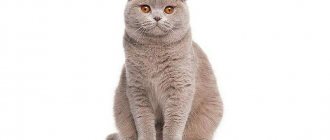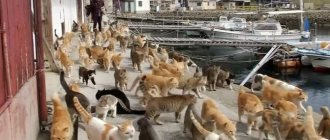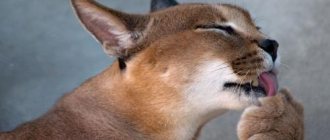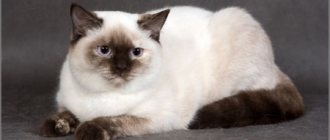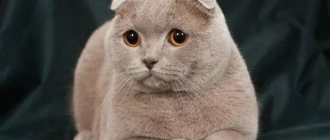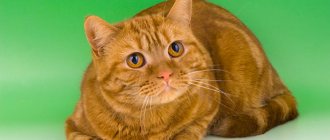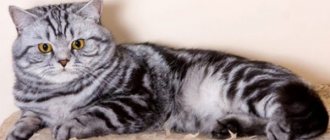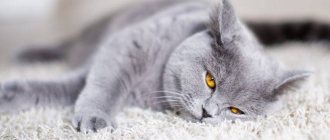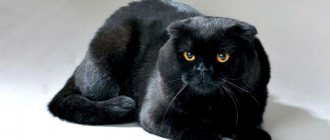Do British Fold cats have fold ears?
It is useless to look for a British fold cat on the lists of international felinological clubs: officially such a breed does not exist. Representatives of the British breed are divided only into short-haired and long-haired, but both have straight ears.
The “British” and their relatives the “Scots” came to Russia in the 1990s. To expand the population, breeders began crossing representatives of both varieties.
The result was the appearance of British Fold cats. From their British parents they received short, dense hair on a stocky body, and from their Scottish parents they received curved ears.
The breed began to enjoy popularity, but in 2004 the international felinological community banned the crossing of “British” and “Scots”. The reason is the frequent manifestation of genetic abnormalities in the offspring: pathologies of the joints and too hard coat.
So the lop-eared “British” remained an unrecognized breed and do not have breed standards. Some breeders generally classify them as “rejected” Scottish cats. Therefore, on the lists of international cat breeding clubs you can only find straight-eared “British” cats.
Difference between the British and the Scots
Some ignorant people call Scottish fold cats “British”, but this is wrong. “Scots” are a separate breed, representatives of which are both straight-eared and fold-eared.
It is not difficult to distinguish between “British” and “Scots”. The characteristic appearance features of both breeds are shown in the table.
| British | Scotsman | |
| torso | stocky, well-muscled, rather large | slender, harmoniously built, medium size |
| limbs | strong, large, round paws | graceful, proportional to the body |
| tail | short, thick, with a rounded tip | quite long, wider at the base than at the end |
| head | large, round, high cheekbones, thick cheeks, short neck | small, with a pronounced chin, prominent neck |
| ears | only straight, ends slightly rounded | can be straight (Scottish Straight) or saggy (Scottish Fold) |
| wool | medium length, voluminous, with thick undercoat | soft, less dense than its British relatives |
How did the Scots appear?
The history of the Fold began in Scotland in the 1960s. from one cat that had floppy ears. Due to an unknown mutation, the animal's ear cartilage was unable to hold its ears upright.
Scottish fold
Breeders became interested in such ears and decided to consolidate these qualities. Already by the 1970s. Fold-eared cats, which were given the name “Scottish fold” (“fold” translated as “fold”), were talked about everywhere.
During selection, in order to get more fold-eared kittens, consanguinity could not be avoided. This in turn led to unpleasant consequences - too many sick animals were born. It turned out that the lop ear gene made not only the ears softer, but all the cartilage in the body. Therefore, the health problems of fold-eared cats, primarily with the musculoskeletal system, were very acute. Animals were born with abnormalities, deformities, and died at an early age. Even those kittens that were healthy at birth subsequently developed various defects, sometimes hidden, and inherited.
For this reason, the fold-eared cat was banned in England and Scotland. The International Cat Federation also opposed it, calling the breed “inhumane.”
Description of the breed
The English ancestor gave the “British” a proportionate, strong body with developed muscles, and the Scottish ancestor gave him an amazing variety of colors.
Although there are no breed standards, breeders identify a British Fold cat by the following external characteristics:
- the head is round, cheeky and high cheekbones, the chin is pronounced;
- the nose is short, smooth, slightly flattened;
- the neck is thick, inconspicuous;
- the eyes are large, round, the color of the iris is determined by the color;
- ears are medium in size, straight or curved, the base is wide, the tip is slightly rounded;
- the chest is voluminous and wide;
- the limbs are strong and short, the paws are rounded, the toes are neatly positioned;
- the tail is short, mobile, the tip is slightly narrowed, rounded;
- The coat is dense and pleasant to the touch, the undercoat is voluminous, the hairs are longer and shorter.
ATTENTION! British kittens are not born with droopy ears. Folding ears begin to appear on the 20th day from birth.
Mr Cat explains: the difference between the British and the Scots
To know the characteristics of the British Fold, it is worth considering the characteristics of the breeds that gave it life - Scottish and British Shorthair.
| Sign | British | Scotsman |
| Ears | Wide, erect, slightly rounded at the tips. | Narrow straight, slightly curved or close to the head. |
| Body structure | Stocky, powerful and squat. | Graceful and embossed, the bone is narrower. |
| Head | Oval, with developed cheekbones and prominent cheeks. | Rounded, with a strong chin and strong jaws, smaller cheeks. |
| Neck | Short, with a fold. | Middle length. |
| Paws | Massive, short. | Slender, proportional to the body. |
| Tail | 2/3 of the length of the body, thick, tapering and rounded towards the end. | Mobile, long, medium thickness. |
| Wool | Plush, short, thick and smooth. | Fluffy, medium to long. |
| Weight | 5-8 kg. | 3-5 kg |
| Character | Discreet and calm, independent, devoted. | Kind and friendly, inquisitive, playful. |
| Health | Strong, good immunity. | Careful care is required, especially for the ears. |
| Peculiarities | Love of heights, lack of the habit of sitting, tendency to loneliness, aristocratic behavior. | Sitting on the butt, standing upright, tendency to learn, ease of adaptation, fear of heights. |
| Crossing | Only within the breed. | Between two types - folds and straights. |
Thus, the outwardly massive British can be distinguished from the Scottish not only by the shape of the ears, but also by other characteristics.
Moreover, when choosing a pet, you should pay attention to its character - a representative of the first breed will be an ideal option for workaholics who spend little time at home. Whereas the affectionate Scot is much more suitable for people with families, with small children and a gentle disposition.
Colors
The coat of a British cat can be either monochromatic or multi-colored, including 2 or 3 colors.
Plain “British” ones are:
- blue (classic version);
- silver-gray;
- white;
- black;
- brown;
- red;
- peach.
Multi-colored cats are:
- tabby (striped color);
- bicolor (a combination of dark and light colors);
- smoky (each hair is transversely divided into two shades);
- "Siamese";
- "tortoiseshells".
Appearance
A little higher, the answer to the question was given: are British cats fold-eared, and now the external characteristics of these animals will be described. British Fold cats and cats are beautiful, strong and muscular pets with round shapes, graceful and flexible bodies. They are large from birth. Around 2-3 years old, a pet reaches maturity. At adulthood, cats weigh approximately 5-8 kg. Cats are inferior to them in weight.
You may notice that British Fold cats, the breed description of which is now given, are characterized by a rather cute face. Its somewhat rounded shape further enhances the feeling of power and strength of the pet. But slightly curved ears somewhat soften the cat’s appearance and give the face a cute and surprised expression. The animal's eyes are round and large. The eye color is mostly copper in color. However, there are animals with greenish, golden, blue, and sometimes multi-colored eyes.
Read also: Why does a dog have a hanging tail?
It should be noted that fold-eared cats, whose price is sometimes high, have very delicate hair with a thick undercoat.
The majority of lovers believe that cats of this breed are exclusively blue, a classic shade. But in fact, the animal is characterized by different colors:
- Plain. The animal's fur can be not only blue, but also white, red, cream and black.
- Smoky. This color is characterized by the following distinctive feature: each hair is colored 1/3 of its length in the main shade, and the rest is white or silver.
- Tortoiseshell. The color has a combination of different colors. Usually there are black animals with reddish spots. The tortoiseshell color also includes a combination of cream and blue, cream and chocolate shades.
- Colorful. Otherwise called Siamese. These cats have a light body. Only their face, limbs, tail and ears are colored.
- Bicolor. This color combines white with some even shade (for example, cream, chocolate, black, chocolate or blue).
- Tabby. This group includes a wide variety of different colors. They are also called patterned, tiger. Cats of this color have dark stripes on a light background. The forehead is marked with a mark somewhat similar to the letter "M", and vertical lines are visible on the back, reminiscent of the body of a butterfly.
Above is a description of what a British cat looks like, this will help you avoid mistakes when choosing and purchasing an animal. Below is a description of some breeds of Scottish fold cats.
Character and habits
British fold-eared pets are calm, non-conflicting, non-aggressive, and phlegmatic. They release their claws only when there is obvious danger, but in most cases they prefer to leave and hide. The “British” remains loyal to his owner only if he takes good care of him.
Positive character traits of the British favorite:
- calm;
- unobtrusiveness;
- curiosity;
- tenderness.
The “British” loves affection, but, like a true aristocrat, does not tolerate being squeezed. He tolerates loneliness without problems and does not require the constant presence of his owner. Also, the British cat is extremely picky about the quality and cleanliness of the tray and resting place.
INTERESTING! British cats are afraid of heights, which is not typical for representatives of other breeds.
Negative characteristics:
- inactivity, lethargy;
- voracity;
- detachment, poor communication.
Relationships with other household members and animals
The British Fold will become a loyal friend and companion for the rest of his cat's life. The cat loves his owner immensely and waits for him to return from work. At the same time, it is unobtrusive and does not require constant attention from a person.
Thanks to his high intelligence, the “British” has a good sense of his master’s mood and knows how to adapt to it. He is not afraid of large crowds of people, noise and din, and shows moderate interest in guests. He is friendly towards other family members and sometimes caresses him.
YOU SHOULD KNOW! The "British" cannot stand human crying. If the owner is whiny and often mopes, then the cat will develop a nervous and aggressive character.
A British Fold cat is an ideal option for a large, calm family. The pet gets along well with children and other pets, even non-aggressive dogs. But he can release his claws if a child mocks him.
Features of care
The breed is capricious; the British Fold requires careful care and high-quality nutrition. Therefore, the potential owner should consider whether he is ready to devote a lot of time and effort to the kitten.
Diet
Representatives of the fold-eared breed are gluttonous, so the owner needs to carefully monitor the diet and control the size of portions so that the pet does not become obese. The cat is fed 3-4 times a day, but the size of one portion should not exceed 200 g.
You can feed the “British” with the best quality ready-made food or natural food.
If the second option is chosen, then the diet includes:
- lean boiled meat and poultry;
- boiled fish without bones;
- boiled chicken or quail eggs;
- boiled vegetables (zucchini, carrots);
- fresh herbs (cucumber, parsley);
- cereal porridges (rice, millet, oatmeal);
- fermented milk products (kefir, cottage cheese).
You should not include salted foods, smoked foods, confectionery and bread products, milk and fatty sour cream, alcoholic beverages, spicy and seasoned foods in your diet.
Hygiene procedures
Clean the cat's ears every 2 weeks. Due to lop ears, dirt and wax quickly accumulate in your pet's ears. For cleaning, use a cotton swab soaked in veterinary ear cleaner.
Every morning the British man's eyes are checked. Accumulations in the tear ducts are removed with a cotton swab moistened with warm water.
Nails are trimmed with a nail clipper once every 3 weeks. Leave no more than 3 mm from the edge so as not to touch the blood capillaries.
They bathe the “British” at most once every six months, using zoo shampoo. And then only if necessary, if the animal is dirty or infected with fleas. Frequent bathing spoils the appearance and structure of the coat. The water is heated to 40 °C.
Castration and sterilization
Representatives of the British Fold cat breed reach sexual maturity at 9 months. If the owner does not plan to breed kittens, then the pet must be castrated or sterilized.
The operation can be performed on a 3-month-old kitten, but stronger and more mature 7–8-month-old kittens are more often castrated. Before the procedure, the animal is examined by a veterinarian and given anthelmintic treatment.
IMPORTANT! In most cases, fold-eared kittens are sold already castrated, since felinological societies prohibit the breeding of an unrecognized breed.
Grooming
The British cat's luxurious, dense coat should be brushed regularly. If this is not done, then the animal will, while licking itself, swallow balls of hair that disrupt the functioning of the digestive tract.
The long-haired "British" is scratched 2 times a week, especially carefully walking the comb over the stomach, back of the head and hind legs. A short-haired cat can be brushed once a week.
Health and vaccination
Fold-eared “Britons” are at risk for genetic pathologies. This is due to the fact that they are descendants of two closely related breeds, one of which carries the gene for lop ears. This gene not only makes the ears original, but can also cause serious pathologies of the skeleton and bone tissue.
IMPORTANT! In kittens born from two lop-eared individuals, osteochondrodysplasia is inevitable - an incurable deformation of the joints. Therefore, fold-eared pets are crossed only with straight-eared ones.
Fold-eared “British” dogs are also susceptible to:
- hearing loss;
- respiratory viral infections;
- claw fungus;
- helminthiasis;
- flea infestation;
- disruption of the heart;
- the appearance of renal cysts.
For preventive maintenance, your pet needs to be shown to a veterinarian annually and vaccinated. Each vaccine is administered according to the time limits established by the veterinarian. Vaccination helps protect your pet from panleukopenia, rabies, and respiratory infections.
A healthy and well-groomed British Fold cat lives about 15 years.
Price
There are many nurseries selling British fold kittens in Russia; finding a pet is not a problem. The breeder must provide the buyer with a veterinary passport and information about the kitten’s parents.
If prices for a purebred “Scottish” cat reach 50 thousand rubles, then a British kitten is much cheaper, because this fold-eared cat is an unrecognized breed. For a British fold kitten they ask from 1000 to 5000 rubles.
The lop-eared “British” is loyal, affectionate, playful, and behaves with dignity. Although he cannot participate in exhibitions and competitions, since his breed does not officially exist, he will become a wonderful companion for a lonely elderly person and a friend for a large family.
Did you like the article?
Kitten toilet
In this matter you need to be persistent and patient .
The kitten needs to choose the most secluded place, for example, a bathroom or toilet. It is important that the toilet is not located near the place where the cat rests and eats. In the tray, which is selected according to the size of the cat, you need to pour a few centimeters of litter for toilets. It must be replaced frequently as it is used. It is better to wash the tray using baby soap and a sponge. If a small pet cannot immediately get used to the tray, under no circumstances should you shout or scold him. You need to put the tray in the place where it “shits” and gradually move the tray closer to the place that you have allocated for it.
The British Fold kitten does not require much hassle in keeping and caring for itself. And if you follow the simple rules of keeping it, the kitten will be active, healthy and will bring a lot of positive emotions to its owner.
Source
